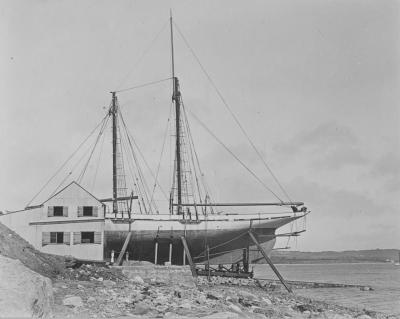Saunders, Roe and Burton of Beaumaris
by John Stops
(Beaumaris)

One of James Hartley Burton's schooners on the slipway under Mount Field
John Stops worked at Saunders-Roe, Fryars, Beaumaris from 1950-1957. In this first article, he deals with the background of the company and of the Fryars estate.
Way back in the 19th century, the Swan, a riverside inn at Streatley on the River Thames was run by a family named Saunders.
Besides running the inn, they maintained the local locks and weirs and ran a ferry across the river.
Their first son was born on 27th May 1857 and was christened Samuel Edgar. As a boy, he built his first boat in his early teens, which created quite a stir locally.
In about 1870, the family set up him and one of his brothers in a boat building business. They quickly gained a reputation for excellence, especially for their river launches, which were fast and made very little wash.
This was due to their fine lines, which meant that the hulls had to be light. To combine lightness and strength, Saunders used veneers, with two layers laid diagonally and an outer fore and aft veneer.
However, instead of the usual method of fastening with boat nails to slender timbers, he developed a construction with the layers stitched together with copper wire. He named this Consuta, from the Greek for sewn together.
The same name was given to the first boat so built which was an umpires launch and was for years used by the BBC to follow the boat race.
Eventually the company found the River too constricting. In 1901 they moved to Cowes in the Isle of Wight, where the business moved from strength to strength with the opportunities that arose from being by the sea.
There followed a period during which of a profusion of notable motor yachts and record breaking high speed motor boats were built.
Samuel Saunders realised that aircraft offered a promising outlet for his Consuta construction and during the First World War the yard built nearly 1,000 aircraft.
After the war, the motor boat business continued to flourish. Aircraft production continued on a small scale, with an increasing emphasis on flying boats.
However, in 1928 when Samuel Saunders was 71 years old, he decided to sell his company. He lived until 1933; a man greatly respected for his technical skill and for his regard for the welfare of his workers and the local community.
During his time, the company received no less than four visits from King George V and Queen Mary, whose residence at Osborne House was just up the road.
Going back now to the year 1907, a young man won a prize for a successful flying model aeroplane. He followed this up in 1908 with the first flight of a British designed and built aeroplane, the Roe Triplane.
The young man's name was Alliot Verdon-Roe. He founded the famous aircraft company A.V. Roe, and the business took off with World War 1 during which a total of some 8,000 Avro 504's were built, including, in a pre-echo of relationships to come, 201 by S.E. Saunders at Cowes.
The company struggled in the years after the First World War, but went on to produce the Lancaster and the cold war icon, the Vulcan.
However, Alliot Verdon-Roe had sold his interest in A.V. Roe in 1928. He used the money to acquire a controlling interest in Saunders, which changed its name to Saunders-Roe in 1929.
Saunders-Roe continued to build boats right up to Word War 2, including a highly regarded range of motor cruisers and Sir Malcolm Campbell's Bluebird which established a new world water speed record of 113.71 knots in 1938.
Another product was lifeboats for the R.N.L.I., of which 61 were built between 1914 and 1937.
On the aircraft side, the company produced an assortment of aircraft, some to its own design and some for others.
In 1938, the Lerwick flying boat made its first flight. Indirectly, it was due to the Lerwick that Beaumaris and the Burton family come into the story.
In the council chamber in the Town Hall, there is a roll of the Mayors of Beaumaris, going back to the date of Edward the 1st's Charter of 1296. On it there is the name of James Hartley Burton. He was Mayor sixteen times, from 1915 to 1931.
Mr. Burton lived at Fryars. If you go northwards from Beaumaris towards Llangoed, you will see the house behind a stone wall facing the sea.
When Mr. Burton lived here it was a beautiful estate. Many of the older people in Beaumaris can remember their forebears working there.
Sailing was a big part of their life and he built the slipway which you can still see below the Northern end of Mount Field.
It was on one of their yachts moored in the on the Conway estuary that Mrs. Burton gave birth to triplets. Sadly, the two boys were killed in the closing months of the First World War and are buried in Llanfaes Churchyard. The surviving triplet, Mary Conway Burton, carried on the yachting tradition by sailing her Fife, Coralie.
She also followed her father by being Mayor of Beaumaris from 1953 to 1956. Mr. Burton died shortly before the war but Mary continued living at Fryars.
She eventually moved to Victoria Terrace and donated the then very large sum of £12,000 for the restoration of the pier, which might otherwise have collapsed.
So how did Saunders-Roe and Fryars come together? See the next instalment!



